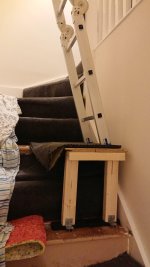@sigma
In your case, I assumed you have got a bit of the darker paint on the lighter coloured walls from the bleed? You want to put the masking tape on the lighter walls at the side and end up making your dark straight lines on the light walls (depending on how much bleed you have). That way, you are covering light paint with dark.
If you do it the other way, putting the masking tape on the darker feature wall, you’ll be finishing up trying to cover the darker paint with light....will will take more coats, might not cover perfectly, and the more paint on the masking tape will make it harder to pull off.
Get some pics up




